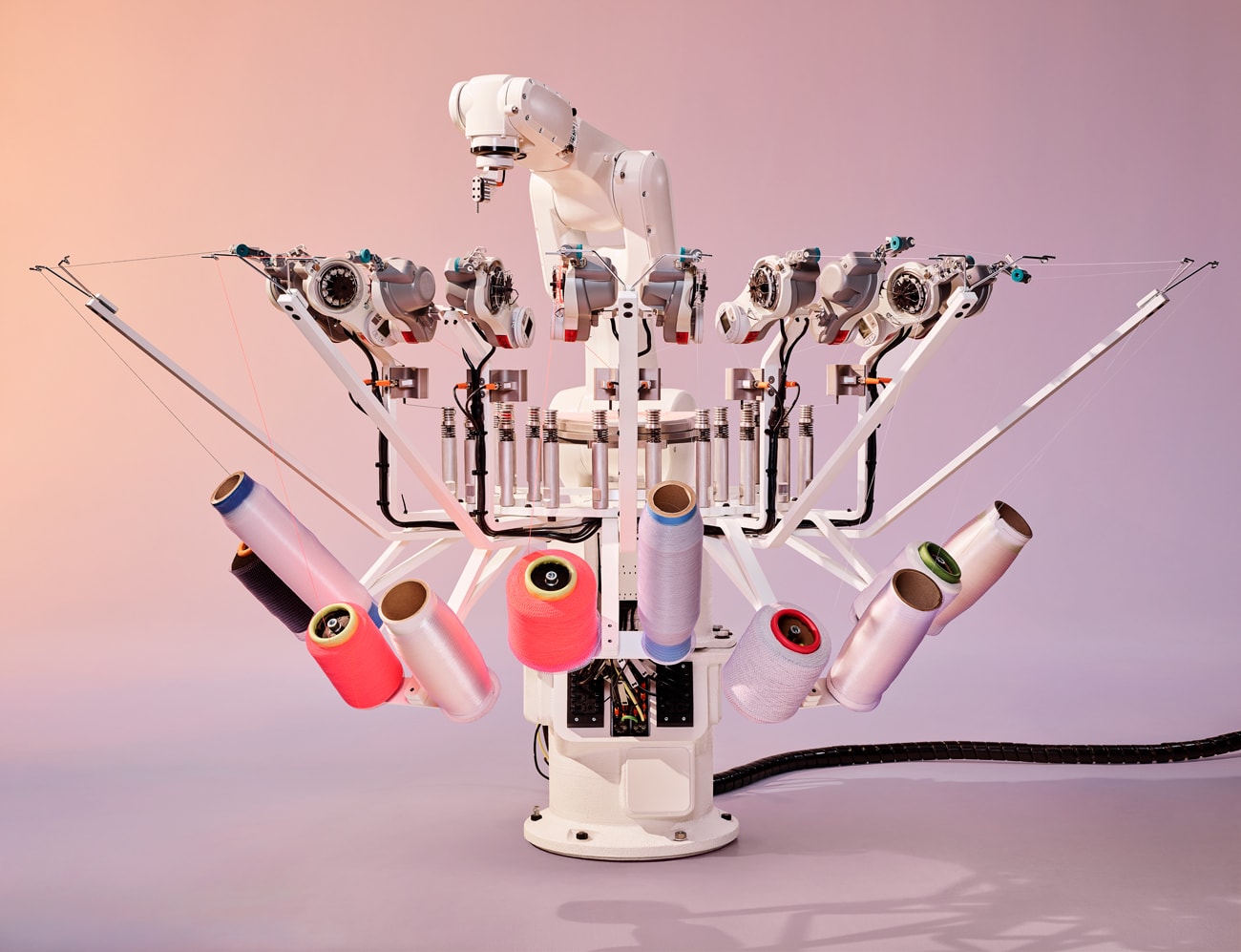With footwear, 3D printing has been making some serious headway, as numerous brands experiment with 3D printed orthotics and midsoles. In its report, “3D-Printed Footwear 2020-2030, an Analysis of the Market Potential of 3D Printing in the Footwear Industry”, SmarTech Analysis projects 3D printing in footwear to generate over US $4.2 billion in annual revenues in 2025.
To really make an impact, however, more than just the midsoles need to be printed. The soft uppers have not been as easy to tackle with 3D printing. For the most part, additive manufacturing (AM) is more of a hard-materials, rather than soft-materials, technology. For this reason, 3D printing has found its way into fashion in an awkward manner, mostly via high concept, plastic pieces that would struggle to make it into consumer wares.
One major manufacturer that seems focused on tackling these limitations is adidas, which seems to have made the most progress in terms of releasing consumer products with 3D-printed features. The brand’s Futurecraft line has seen a number of 3D printed midsoles hit virtual shelves over the past several years and the latest pair of sneakers in the collection includes soft uppers made using an autonomous weaving robot.
The FUTURECRAFT.STRUNG is a proof-of-concept sneaker that was made by a custom-built robot that threads color-coded yarn across a 3D-printed midsole. While the red strings are meant to be stiffer and stronger to hold the wearer’s heel in place and providing a durable toe-box and midfoot, the yellow string are softer and add flexibility to the forefoot of the shoe. The threads are woven in a programmed manner, with each one placed exactly where they are designed to go—a bit like 3D printing.
The pairs made so far were designed to fit the performance data provided by professional runners. The uppers were then robotically weaved so that only the necessary material was used, reducing the weight of the shoes and waste. The STRUNG prototype weighs 220 grams (7.7 oz), a significant drop in weight compared to the 4D Run 1.0, a shoe whose heavy, 3D printed midsole contributed to its 366-gram (12.9oz) mass.
Adidas aims to have the product in the market by late 2021 or early 2022, targeted toward road runners with speeds of five meters per second. If the company is able to deliver, it will have made important strides toward a number of important goals, namely reducing the waste and labor associated with the consumption of shoes.
Adidas claims to be taking efforts to ensure the fair treatment of the workers in its supplier factories and it is considered one of the more transparent of the athletic wear manufacturers when it comes to its supply chain. However, the company still has work to do, particularly when it comes to ensuring a fair wage for garment producers in third world countries.
With roughly 300 million pairs of shoes in landfills per year, the amount of waste from the footwear industry is substantial. Here, again, adidas has made commitments to sustainability and received recognition from some environmental groups in response.
Automating the production of shoe manufacturing via 3D printing and robotic stitching could impact these issues by reducing its dependence on underpaid labor (which could alternatively be addressed by spending fewer funds on athlete contracts and executive compensation) and reducing the amount of material used to make shoes.
However, as 3DPrint.com Executive Editor Joris Peels has pointed out in his Brittle Spear series, much of the waste associated with consumerism has become ingrained in our culture. Therefore, breaking the cycles associated with unethical consumption may require more than slow-moving initiatives from manufacturers, but might also necessitate a fundamental change to our culture. What Peels doesn’t address is the fact that economic growth is also built into our existing system, which naturally drives companies to seek greater profits from the release of an unending series of products that then contribute to issues such as ecological destruction and human rights abuses.
Adidas may be winning the race in 3D printed footwear, potentially ramping up its Speed Factories that use Carbon’s 3D printing technology to manufacture midsoles. Though the competition is steep, as New Balance, Under Armour, Nike and others have experimented with limited releases of shoes with 3D printed parts. Voxel8 has even developed a method for producing shoe uppers with 3D printing. However, none of us are winning the race against the larger problems of social and economic inequality and ecological collapse.
[Image courtesy of adidas.]Subscribe to Our Email Newsletter
Stay up-to-date on all the latest news from the 3D printing industry and receive information and offers from third party vendors.
Print Services
Upload your 3D Models and get them printed quickly and efficiently.
You May Also Like
South Korean 3D Printing Industry Sounds Alarm Over Data Leakage
An article recently published in BusinessKorea has highlighted that small and medium-sized enterprises (SMEs) utilizing additive manufacturing (AM) in South Korea are increasingly worried about the threat of leaking intellectual...
MetalWorm Sells WAAM Systems to Research Institutes in Brazil and Malaysia
Turkish WAAM firm MetalWorm has sold a system in Malaysia and another in Brazil. This is an excellent example of a few emerging trends in additive. Firstly, WAAM was experimented...
From Rapid Qualification to On-ship 3D Printing, ABS Sets New Standards in Maritime AM
The American Bureau of Shipping (ABS) is taking significant strides in advancing additive manufacturing (AM) within the maritime sector. Amidst increasing interest and the need for modernization, ABS has been...
HAMR Industries Gets a FormAlloy X5R at Neighborhood 91
The Neighborhood 91 (N91) cluster of additive manufacturing firms in Pennsylvania has acquired a FormAlloy robot arm X5R Directed Energy Deposition (DED) system; specifically HAMR Industries. The X5R can work...


































